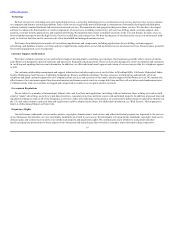Juno 2014 Annual Report Download - page 21
Download and view the complete annual report
Please find page 21 of the 2014 Juno annual report below. You can navigate through the pages in the report by either clicking on the pages listed below, or by using the keyword search tool below to find specific information within the annual report.
Table of Contents
have taken adequate steps to prevent infringement or misappropriation of our intellectual property and proprietary rights. Our failure to adequately protect
our intellectual property and proprietary rights could adversely affect our brands and could harm our business. We are also subject to the risk of claims
alleging that our business practices infringe on the intellectual property rights of others. These claims could result in lengthy and costly litigation. Moreover,
resolution of any such claim against us may require us or one of our subsidiaries to obtain a license to use the intellectual property rights at issue or possibly
to cease using those rights altogether. Any of those events could have a material adverse effect on our business, financial condition, results of operations, and
cash flows.
Fluctuations in foreign currency exchange rates could adversely affect comparisons of our operating results.
We transact business in various foreign currencies and may be exposed to market risk resulting from fluctuations in foreign currency exchange rates. Our
primary currency exposures are the Euro and Indian Rupee, and to a much lesser extent, the Swedish Krona and Swiss Franc. International revenues and
expenses denominated in foreign currencies translate into higher or lower revenues and expenses in U.S. Dollars as the U.S. Dollar weakens or strengthens
against such other currencies. Substantially all of the revenues of our international businesses are received, and substantially all expenses are incurred, in
currencies other than the U.S. Dollar, which increases or decreases the related U.S. Dollar-reported revenues and expenses depending on the fluctuations in
foreign currency exchange rates. Certain of our key business metrics, such as the Content & Media segment's average monthly revenue per pay account
(which we also refer to as ARPU), are similarly affected by such foreign currency exchange rate fluctuations. Changes in global economic conditions, market
factors, and governmental actions, among other factors, can affect the value of these currencies in relation to the U.S. Dollar. A strengthening of the U.S.
Dollar compared to these currencies and, in particular, to the Euro, has had, and in future periods could have, an adverse effect on the comparisons of our
revenues and operating income against prior periods. We cannot accurately predict the impact of future foreign currency exchange rate fluctuations on our
operating results, and such fluctuations could negatively impact the comparisons of such results against prior periods as well as our business, financial
condition, results of operations, and cash flows. We use derivative instruments, such as foreign currency forward contracts, to hedge certain exposures to
fluctuations in foreign currency exchange rates. The use of such instruments may not offset any, or more than a portion, of the adverse financial effects of
unfavorable movements in foreign currency exchange rates.
We may not realize the benefits associated with our assets and may be required to record a significant charge to earnings if we are required to expense
certain costs or impair our assets.
We have capitalized goodwill and identifiable intangible assets in connection with our acquisitions and certain business initiatives. We perform an
impairment test of our goodwill annually during the fourth quarter of our fiscal year or when events occur or circumstances change that would more likely
than not indicate that goodwill or any such assets might be permanently impaired. If our acquisitions or business initiatives are not commercially successful
or, if due to economic or other conditions, our assumptions regarding the performance of our businesses or business initiatives are not achieved, we would
likely be required to record impairment charges which would negatively impact our financial condition and results of operations. We have experienced
impairment charges in the past, including a $55.4 million goodwill impairment charge in the year ended December 31, 2013 with respect to our Classmates
reporting unit. Given the current economic and competitive environment and the uncertainties regarding the impact on our businesses, we cannot assure you
that our estimates and assumptions regarding the duration of the challenging economic conditions, or the period or strength of recovery, made for purposes of
our goodwill and identifiable intangible assets impairment testing will prove to be accurate predictions of the future. If our assumptions regarding forecasted
revenues or growth rates of certain reporting units or other factors are not achieved or are revised downward, we may be required to record additional
impairment charges in future periods. If our operating segments
20
























